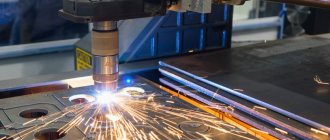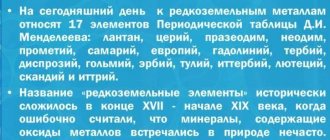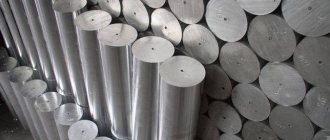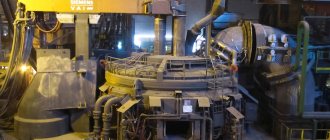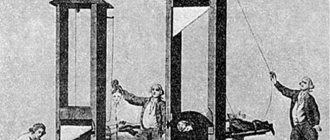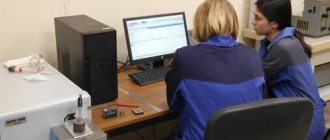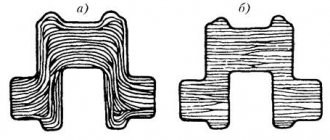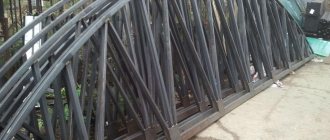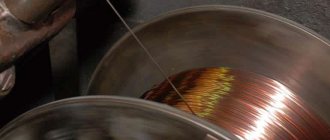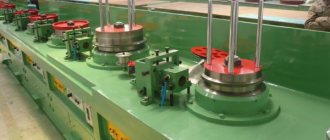Mechanical cutting
In this case, the metal workpiece being processed is separated in the process of direct contact with the cutting tool. The latter is made from metals of greater hardness.
The process can occur using hand tools or special machines.
In the first case, the wizard uses:
- Scissors with several types of cutting edges: for straight or curved cutting, mirror and straight finger type
There are stationary models in which one of the blades is fixed in the workbench, and the second is movable.
- Saws of different designs
| Manual | for work they are placed in a C-shaped frame |
| Disk | can be manual or electric |
| End | Designed for cutting at desired angles |
| Pendulum | distinguished by carbide end brazings |
| Circulating | the working end has carbide, abrasive tips |
- pipe cutters
The accuracy of the work and the speed of its completion are completely determined by the professionalism of the performer. And the thickness of the cut workpieces is significantly limited, especially when working with slotted scissors.
- Angle grinders (grinders)
The manual method has very low productivity. Therefore, it is used only in everyday life.
In the second, the following machine equipment is used:
- band sawing machines (LSS);
- units that perform longitudinal cutting of metal;
- turning;
- guillotine: electromechanical, pneumatic, hydraulic;
- disk.
Material cutting technologies
Cutting materials is in demand in many industries, as well as in everyday life.
Today, a lot of effective methods have been invented with which you can divide (differentiate) materials into parts and give them a certain shape. These methods can be represented in two large groups:
The 1st group uses mechanical action: processing and cutting with a grinder, using scissors, guillotines, milling, stamping, etc.
The 2nd group uses the properties of the jet and the plasticity of materials when they are heated to critical temperatures as their main instrument of influence. The second group also includes many methods. The following cutting is used:
- Gas-flame, which is divided into oxygen; oxygen with flux supply and oxygen-lance
- Using gas and electric arc. At the same time, the word “gas” means the use of ordinary air or oxygen from a cylinder
- Electroerosive
- Plasma of direct and indirect action
- Laser in air, or in a flow of oxygen or mixtures of argon with helium, hydrogen, oxygen (gas laser)
- Laser assisted oxygen cutting (LASOX) - supersonic cutting with oxygen heated by a laser beam.
- Hydrojetting and water cutting.
- Supersonic cryogenic
Gas or gas-flame processing (oxygen cutting) is used to cut carbon and low-alloy steel. In this process, a chemical reaction of O2 with Fe occurs, as a result of which a stream of oxygen evaporates the metal from the cut zone and blows out oxides and scale.
The essence of oxygen-flux cutting remains the same as in the previous case. It is used when working with metals that form refractory oxides. During combustion, the introduced flux releases additional heat into the cutting zone, and the refractory components melt and are blown away by a stream of oxygen in the form of slag. In addition, the flux does not burn immediately and has an abrasive effect on structures that are difficult to remove from the melt.
The basis of the electroerosive method is the physical phenomenon according to which the destruction of metal occurs under the influence of electrical discharges. Thus, we have learned to derive benefit from electrical breakdown, which is harmful in most cases. The process can take place in a bath filled with kerosene or distilled water. A wire passes through the product, immersed in a conductive liquid and acting as an anode, which is given uniform longitudinal and transverse movement. The resulting discharge has a greater destructive effect on the anode than on the cathode. This is the essence of cutting through electrical erosion.
In plasma cutting, an analogue of the cutter is the plasma flow. An electric arc is disturbed between the electrode and the plasma torch nozzle, or between the electrode and the workpiece. At this moment, a stream of air is supplied, which, under the influence of pressure and arc, is ionized and turns into a jet of high-temperature plasma. The temperature of the plasma can reach 30,000 degrees Celsius, and its speed can be 1,500 m/s.
The arc burns between the electrode and the workpiece - this is direct cutting. You can work with ferrous and corrosion-resistant steels and non-ferrous metals.
The arc burns between the electrode and the nozzle - this is indirect cutting. The indirect method allows you to work with dielectric materials (non-metals) or with materials that have weak electrical conductivity.
Gas laser cutting . When using continuous-wave carbon dioxide lasers, a gas flow is supplied to the contact area of the laser beam with the surface being treated. The gas is selected depending on the type of material being cut. In some cases, the gas flow cools the edges of the cut and prevents the expansion of its boundaries and the combustion of the material; in others, the jet blows the molten material out of the beam’s action area.
A laser beam can heat the metal surface to a temperature of 1000 degrees Celsius, then the oxidation process develops, at which point oxygen is supplied, the speed of which exceeds the speed of sound. This technology is called assisted oxygen cutting.
The principle of operation of a waterjet is clear from its name. Cutting is performed by controlling the high-speed (can be several times the speed of sound) movement of a water jet. When waterjet cutting, solid particles are added to the water, which increase the effect of the destructive force acting on the material.
Here are photos of tiles cut using waterjet cutting. You might think that this is something prohibitively expensive. In fact, the cutting service itself is not that expensive.
And finally, the innovative technology of cryogenic “cutting” is considered a process that will be actively used in the future. A low-temperature stream of liquefied nitrogen supplied with enormous pressure can cut even products made from heavy-duty materials.
LPS
Used for cutting sheet and section metal. Replaceable band saw blades are their cutting element. Manufactured from bimetallic alloys and carbon steels.
The principle of operation is similar to making a cut with scissors. The saw blade is enclosed in a ring belt, which is continuously rotated by an electric motor, which provides an average cutting speed of about 100 mm/min. The optimal blade width is 1.5 mm.
Among the advantages of this technology are:
- high cutting precision;
- possibility of making straight and angular cuts;
- small amounts of waste;
- minimum cutting thickness;
- affordable price.
Industrial types of metal cutting
The most popular cutting technologies allow the production of the maximum number of high-precision parts in a short period of time. Large enterprises most often use:
- plasma;
- laser;
- gas;
- waterjet
- metal cutting on CNC machines
Plasma cutting is the processing of conductive metals and dielectrics of any hardness with a stream of hot gas (plasma) at a temperature of 5-30 thousand degrees Celsius, accelerated by an electric field to a speed of about 1500 m/s. Mostly sheet metal up to 200 mm thick is cut. After passing the plasma jet, a very thin, even and smooth cut is obtained, which does not require additional processing of the edges. Plasma cutting technology is one of the most accurate and fastest. The metal zone adjacent to the cut does not overheat and its structure is not disturbed.
Laser cutting technology
Laser cutting is not inferior in accuracy to plasma processing. In this case, the working body is a powerful laser beam with high focusing accuracy. The metal instantly melts, burns and evaporates, leaving a clean, narrow cut. If sheets with a thickness of more than 15 mm are processed, the cutting area is additionally blown with inert gas, air or cooled with water. Laser cutting is most often used in the manufacture of parts with complex contours from non-ferrous metals, alloys and steels with a thickness of 12-20 mm. The advantage is the ability to cut ultra-thin and very fragile materials.
Waterjet cutting, unlike previous methods, involves mechanical rather than thermal effects. But the cutter is ordinary water mixed with abrasive powder, supplied under high pressure.
Provides a cut with a thickness of no more than 0.5-1.5 mm on sheets up to 300 mm thick. Moreover, the entire process occurs at temperatures no higher than 90 0C, which completely eliminates thermal changes in the structure of the metal and the release of hot vapors that are dangerous to humans.
Waterjet cutting of metal on CNC machines makes it possible to process packages of several sheets, which is very convenient for large-scale production. The disadvantage is the possibility of corrosive effects.
Gas cutting of metal, like cutting by welding (electrode), involves exposing the material to a temperature that is significantly higher than the melting point in a limited area of action of the oxygen-propane flow. It is characterized by low cutting accuracy, but does not require overly complex equipment and can be performed in any conditions. Cutting with electrodes brings the same results, but requires connecting the equipment to an electrical outlet.
Guillotine
The use of this equipment is considered as a private option, impact cutting (another name, cutting). In demand at the stage of procurement work with sheet metal (ferrous, electrical steel, galvanized, stainless steel) for subsequent stamping.
A significant difference from other cutting technologies is the cutting of the workpiece simultaneously along the entire future length of the cut. The result is a smooth edge that does not require modification. Contact with the workpiece, thanks to the design of the guillotine, is carried out at one point, which moves along the workpiece, which is reminiscent of cutting metals with scissors.
The disadvantages are the high noise level of operation and restrictions on the thickness of the workpiece being processed.
Laser cutting
The working tool of such equipment is a high-energy monochromatic laser beam. The light emitted by the laser hits the metal, heats it in a narrow zone to a temperature well above the melting point and evaporates it. Combustion products are removed with a jet of inert gas, which prevents oxidation of the edges of the hot metal, or with a coolant.
The absence of mechanical contact with the workpiece allows you to cut thin sheets, brittle materials and achieve an extremely precise contour line of the part. The ability to rotate the laser emitter at any angle allows you to create workpieces with a curved configuration. The laser beam acts on conductive metals and dielectrics, regardless of their electrical resistance. This makes the laser cutting method truly universal.
To carry out such work, contact. We specialize in laser processing of metals and other materials. We have a large fleet of equipment to solve the most complex problems. The machines use laser, as well as solid-state, fiber and gas sources.
Waterjet cutting
This technology is unique and inimitable in its own way, distinguished by its ability to solve a wide range of problems and significant versatility.
Metal cutting is performed by applying a jet of water mixed with abrasive materials to the surface of the workpiece under high (up to 5000 atm) pressure.
Increased productivity is achieved by simultaneous cutting of thin sheets of blanks stacked.
Modern technology provides significant precision in cutting metals along a line of any geometry.
The advantages of the option are:
- protection of the workpiece material from melting and deformation due to low temperatures in the cutting area;
- minimum amount of waste;
- efficient cutting of elements with a non-standard configuration.
Main disadvantages:
- restrictions on the type of workpiece material and its thickness;
- high price of equipment.
Plasma and gas cutting of metal - what are they good for?
Plasma and gas cutting of metal are the most modern and technologically advanced methods of processing this material. Let's look at each method separately:
- Plasma cutting is carried out as follows: the metal along the cut line is melted using an electric arc, then the remaining material is removed by exposure to a high-speed plasma flow. This is a complex procedure that requires appropriate equipment and high skill of performers. The method is often used in mass production, since it has no analogues in the modern world in terms of price-quality ratio. Plasma cutting is characterized by versatility - it is suitable for black and stainless steel, aluminum and copper, brass and titanium. Its advantages include: high speed, even cut, local heating of the product (which prevents its deformation), and the ability to create parts of complex geometric shapes.
- Gas cutting is the processing of metal with a mixture of oxygen and flammable gases. Before starting the operation, the material is heated at the starting point of the cut to the melting temperature. The method is excellent for cutting carbon steels, including thick ones.
Trest PSM-71 LLC offers an integrated approach to the creation of metal structures - their design, production, installation. All work is carried out in strict accordance with the current legislation of the Russian Federation, norms and standards. All necessary approvals, permits, certificates and licenses are available.
We use the most modern metal cutting technologies, so our products are of high quality and reliability.
Our clients include large Russian and foreign organizations. Our plant participated in the reconstruction of the Alexandrinsky Theater, the Constitutional Court of the Russian Federation (the Senate and Synod buildings).
Interested in plasma and gas cutting? Specialists of Trest PSM-71 LLC are always at your service. We will help you avoid problems and unnecessary expenses!
Services of the Trest PSM-71 plant for plasma and gas cutting
Manufacturing of metal structures is the main specialization of our plant. We create them taking into account all subsequent links in the technological chain. Designers know all the intricacies of production and are well versed in materials existing on the market.
We are always ready to answer customer questions and provide expert advice! A high degree of competence in the core and related fields allows our employees to help the client understand the specifics of the technical implementation of the project. If our specialists see that the project is impossible or difficult to implement within the budget, they can make design changes that do not contradict the basic concept, which will allow it to stay within the budget.
The Trest PSM-71 plant, among others, offers services for plasma and gas cutting of metal. We guarantee product reliability and fulfillment of contractual obligations in full!
Our production
The production of metal structures is carried out in-house - in a workshop located in St. Petersburg.
Our arsenal includes: high-tech installations for plasma and gas cutting of metal, modern welding equipment, band saws, radial drilling machines, thread-cutting equipment.
Plasma and gas cutting of metal: attractive price, high quality
How to determine the cost of plasma and gas cutting of metal? To do this, you need to take into account the following factors:
- metal type;
- cutting difficulty level;
- volume of work and required deadlines for their completion.
Want to know specific numbers? Our managers will be happy to advise you!
Plasma and gas cutting of metal - estimate
It’s safe to cooperate with Trest PSM-71 LLC. We guarantee openness and transparency of all processes! Much attention is paid to drawing up estimates for plasma and gas cutting of metal.
It includes:
- the cost of individual operations, as well as the final price for manufacturing the part;
- calculation of costs for creating the required conditions for cutting;
- a list of basic standards used when cutting metal.
When working with us, you know what you pay for!
Plasma and gas cutting of metal according to GOSTs and SNiPs - quality guarantee
Trest PSM-71 LLC creates products that meet all technological requirements, GOSTs and SNiPs, on the basis of which the production, design and installation of metal structures is carried out.
Our designers are qualified, welders are certified, and equipment is certified.
Plasma and gas cutting of metal in St. Petersburg. Contact us!
offers plasma and gas cutting of metal in St. Petersburg at affordable prices. Our experienced specialists guarantee high quality products and compliance with deadlines!
Thermal cutting
The methods and technologies combined in this group are non-contact. There is no direct contact between the surface of the workpiece and the cutting tool. Separation into several parts is carried out thanks to a jet of gas, plasma, or laser beam. This technology can be used for cutting workpieces, producing holes with the required cross-section, and correcting certain parts of the workpiece.
The principle underlying thermal cutting is the evaporation of the metal located in the cutting zone due to the effect of high temperatures on it.
Based on the method of transferring such temperature to the cutting zone, the following types of technologies are distinguished.
Industrial machines
In large metalworking workshops and workshops, in addition to mechanical ones, a number of other, more productive and accurate methods of metal cutting are used. The following are used as cutting tools:
- plasma;
- laser ray;
- flame;
- jet of water under pressure.
These are exclusively industrial methods that are not used in everyday life and handicraft workshops, except for gas cutting. They require complex and expensive equipment, consume a lot of electricity and pay for themselves only with constant capacity utilization.
Oxygen gas cutting
This operation is performed in two stages. At the first stage, the cutting site is heated to the ignition temperature of the workpiece material. A gas cutter is used for this. The gas used at this stage is acetylene (in the vast majority of cases). The time required for heating is determined by the thickness of the workpiece, grade of material, and surface condition.
Once the required temperature is reached, oxygen is supplied. A jet of flame under a certain pressure moves along the cutting line and cuts through the entire thickness of the workpiece. In this case, oxygen blows out the oxides that form on its side faces from the cut.
To obtain a cut of maximum quality, you must strictly maintain a fixed distance between the surface and the cutter. It is extremely difficult to achieve this when doing work manually.
Therefore, in production they use automatic machines with oxygen gas cutters. This ensures high-quality high-speed cutting.
Advantages of the method:
- ability to cut titanium sheets;
- workpieces having a large thickness (2-2000 mm);
- simplicity of technology;
- possibility of cutting multilayer materials;
- equipment mobility;
- reasonable price of the unit and cost of work.
Flaws:
- the technology does not allow cutting non-ferrous metals, chromium-nickel and high-carbon steel;
- the cut is quite wide, has poor-quality edges with sagging and oxides, which requires additional finishing;
- it is impossible to cut curved surfaces;
- the material in the cut area changes its physical properties.
CNC thermal metal cutting
The CNC unit ensures maximum equipment performance and the best quality of manufactured elements.
The advantages of devices with a built-in software control unit include:
- The ability to create products that require jewelry precision. The hardware and software follow the algorithm laid down by the development engineer.
- The ability to repeat manipulations, limited only by the amount of oxygen and the durability of the device.
- Impressive performance. The operation of the equipment is not limited by human physiological capabilities.
The above advantages justify the significant popularity of this type of units in production.
However, purchasing equipment with a CNC unit is not economically viable for one-time operations. In this regard, one-time production of parts is entrusted to third-party manufacturers who have the necessary stationary devices. It should be borne in mind that an exchange of services of this kind is divided into two categories: the actual creation of the required elements and the writing of software for control units.
Oxygen-flux
It is based on the interaction of the high temperature formed in the flux, previously applied to the surface of the future cut. This simplifies the cutting of rotational bodies and rolled beams while maintaining high cut quality.
The use of fluxes ensures cutting of workpieces made of cast iron, high-alloy steels, stainless steels, aluminum alloys, copper, and slagged metals.
It is possible to cut metals using:
- welding inverters (limited list of metal grades and workpiece thicknesses, low cut quality);
- argon arc cutting (allows you to work with carbon steels and non-ferrous metals).
Plasma
Such cutting of metals is carried out using a plasma torch (plasma generator). This is special equipment. The cutting tool is the generated plasma jet.
Plasmatrons are divided into devices of direct and indirect action.
In the first case, such a product is an element of the electrical network, where the workpiece acts as an anode, and the plasma torch head is the cathode. It is between them that an electric arc is formed, heating the metal, and a plasma discharge.
In the second, an electric arc is formed inside the plasmatron. A plasma jet acts on the workpiece.
Air (various gases) can be used as a working fluid. There are models of steam-water plasmatrons (water cooling).
How the device works
- gas under excess pressure enters the arc chamber through a vortex generator;
- a primary arc is formed between the nozzle and the electrode, ensuring the subsequent creation of a working electrical discharge;
- due to high temperatures and generated heat, plasma is formed, which is an ionized gas;
- the required speed of the flow is given by the geometry of the nozzle.
The metal heats up and melts. The melt is removed from the cut by a gas flow. The following types of plasmatrons are available on the market:
- gas plasma;
- air-plasma;
- high frequency (induction);
- steam-water;
- combined.
There are manual and stationary versions. The latter can be equipped with CNC. Their productivity and quality of work are significantly higher.
The plasma temperature can reach 20,000°C. the average width of the formed beam is 3 mm.
The use of such technology ensures cutting of metals up to 150 mm thick; the optimal thickness is considered to be (1.5-40.0) mm.
Plasma torches are recommended to be used to perform the following types of work:
- if it is necessary to cut an element of complex geometry from a sheet blank;
- in the production of parts that do not require additional processing and have rectilinear contours;
- cutting profiles, rods, pipes, strips and then giving the ends a given shape;
- cutting holes and openings in metal blanks;
- processing and preparation of edges for subsequent welding;
- production of blanks for their subsequent welding and stamping;
- processing of casting blanks.
Pros: one equipment can be used for cutting workpieces from any materials; with a workpiece thickness of up to 20 mm, the cutting speed is quite high; use of inexpensive gases; minimal thermal deformation of workpieces; ease of automation technology.
Cons: high price of equipment; increased complexity of operation and maintenance; requirement for a cooling system for the burner; high professional training of the operator.
Plasma cutting
One of the most productive cutting methods. The working tool is a stream of hot gas heated to a temperature of 5000–30,000 °C. The flow of ionized gas is accelerated in an electric field to a speed of about 1500 m/s and melts the metal in a narrow zone of the cut line. The melt is blown out by a plasma stream, without having time to form beads and seams, and the edges of the part are cooled by water and, as a result, do not heat up and do not change the structure.
Plasma cutting provides high precision lines and smooth edges. The resulting parts do not require additional mechanical processing. Industrial CNC equipment allows cutting metals and non-metals up to 200 mm thick. Used in large-scale production and manufacturing of piece parts with complex configurations.

